Tensile Creep Behavior of Quasi-Unidirectional E-Glass Fabric Reinforced Polypropylene Composite
Abstract
:1. Introduction
2. Modeling of Creep Behavior
3. Experiments
3.1. Materials and Samples
3.2. Experimental Procedure
4. Results and Discussion
4.1. Creep Behavior
4.2. Identification of Material Parameters for Creep Model
4.3. The Validation of Model
5. Conclusions
Author Contributions
Funding
Acknowledgments
Conflicts of Interest
References
- Van den Oever, M.; Peijs, T. Continuous-glass-fibre-reinforced polypropylene composites II. Influence of maleic-anhydride modified polypropylene on fatigue behaviour. Compos. Part A Appl. Sci. Manuf. 1998, 29, 227–239. [Google Scholar] [CrossRef]
- Brauner, C.; Herrmann, A.S.; Niemeier, P.M.; Schubert, K. Analysis of the non-linear load and temperature-dependent creep behaviour of thermoplastic composite materials. J. Thermoplast. Compos. Mater. 2017, 30, 302–317. [Google Scholar] [CrossRef]
- Ehrenstein, G.W. Polymeric Materials: Structure, Properties, Applications; Carl Hanser Verlag GmbH Co KG: Munich, Germany, 2012. [Google Scholar]
- Liou, W.; Tseng, C. Creep behavior of nylon-6 thermoplastic composites. Polym. Compos. 1997, 18, 492–499. [Google Scholar] [CrossRef]
- Chung, I.; Sun, C.; Chang, I. Modeling creep in thermoplastic composites. J. Compos. Mater. 1993, 27, 1009–1029. [Google Scholar] [CrossRef]
- Papanicolaou, G.; Zaoutsos, S. Viscoelastic constitutive modeling of creep and stress relaxation in polymers and polymer matrix composites. Creep Fatigue Polym. Matrix Compos. 2010, 1–47. [Google Scholar]
- Pegoretti, A.; Ricco, T. Creep crack growth in a short glass fibres reinforced polypropylene composite. J. Mater. Sci. 2001, 36, 4637–4641. [Google Scholar] [CrossRef]
- Robert, M.; Roy, R.; Benmokrane, B. Environmental effects on glass fiber reinforced polypropylene thermoplastic composite laminate for structural applications. Polym. Compos. 2010, 31, 604–611. [Google Scholar] [CrossRef]
- Vas, L.M.; Bakonyi, P. Creep failure strain estimation of glass fibre/polypropylene composites based on short-term tests and Weibull characterisation. J. Reinf. Plast. Compos. 2013, 32, 34–41. [Google Scholar] [CrossRef]
- Chevali, V.S.; Janowski, G.M. Flexural creep of long fiber-reinforced thermoplastic composites: Effect of processing-dependent fiber variables on creep response. Compos. Part A Appl. Sci. Manuf. 2010, 41, 1253–1262. [Google Scholar] [CrossRef]
- Fliegener, S.; Hohe, J.; Gumbsch, P. The creep behavior of long fiber reinforced thermoplastics examined by microstructural simulations. Compos. Sci. Technol. 2016, 131, 1–11. [Google Scholar] [CrossRef]
- Ropers, S.; Kardos, M.; Osswald, T.A. A thermo-viscoelastic approach for the characterization and modeling of the bending behavior of thermoplastic composites. Compos. Part A Appl. Sci. Manuf. 2016, 90, 22–32. [Google Scholar] [CrossRef]
- Findley, W.; Lai, J.; Onaran, K.; Christensen, R. Creep and relaxation of nonlinear viscoelastic materials with an introduction to linear viscoelasticity. J. Appl. Mech. 1977, 44, 364. [Google Scholar] [CrossRef]
- Gates, T.S.; Sun, C. Elastic/viscoplastic constitutive model for fiber reinforced thermoplastic composites. AIAA J. 1991, 29, 457–463. [Google Scholar] [CrossRef]
- Guedes, R. Viscoplastic analysis of fiber reinforced polymer matrix composites under various loading conditions. Polym. Compos. 2009, 30, 1601–1610. [Google Scholar] [CrossRef]
- Ogihara, S.; Moriwaki, S. Tensile creep deformation in unidirectional carbon/epoxy laminates under off-axis loading. J. Mater. Sci. 2004, 39, 3465–3467. [Google Scholar] [CrossRef]
- Wang, C.; Sun, C. Experimental characterization of constitutive models for PEEK thermoplastic composite at heating stage during forming. J. Compos. Mater. 1997, 31, 1480–1506. [Google Scholar] [CrossRef]
- Vasiukov, D.; Panier, S.; Hachemi, A. Non-linear material modeling of fiber-reinforced polymers based on coupled viscoelasticity–viscoplasticity with anisotropic continuous damage mechanics. Compos. Struct. 2015, 132, 527–535. [Google Scholar] [CrossRef]
- Sun, C.; Chen, J. A simple flow rule for characterizing nonlinear behavior of fiber composites. J. Compos. Mater. 1989, 23, 1009–1020. [Google Scholar] [CrossRef]
- Zhai, Z.; Jiang, B.; Drummer, D. Characterization of nonlinear response in quasi-unidirectional E-glass fabric reinforced polypropylene composites under off-axis tensile loading. Polym. Test. 2017, 63, 521–529. [Google Scholar] [CrossRef]
- Thiruppukuzhi, S.V.; Sun, C. Models for the strain-rate-dependent behavior of polymer composites. Compos. Sci. Technol. 2001, 61, 1–12. [Google Scholar] [CrossRef]
- Ladeveze, P.; LeDantec, E. Damage modelling of the elementary ply for laminated composites. Compos. Sci. Technol. 1992, 43, 257–267. [Google Scholar] [CrossRef]
- Cho, J.; Fenner, J.; Werner, B.; Daniel, I. A constitutive model for fiber-reinforced polymer composites. J. Compos. Mater. 2010, 44, 3133–3150. [Google Scholar] [CrossRef]
- Zhai, Z.; Gröschel, C.; Drummer, D. Tensile behavior of quasi-unidirectional glass fiber/polypropylene composites at room and elevated temperatures. Polym. Test. 2016, 54, 126–133. [Google Scholar] [CrossRef]
- Kawai, M.; Morishita, M.; Satoh, H.; Tomura, S.; Kemmochi, K. Effects of end-tab shape on strain field of unidirectional carbon/epoxy composite specimens subjected to off-axis tension. Compos. Part A Appl. Sci. Manuf. 1997, 28, 267–275. [Google Scholar] [CrossRef]
- Sun, C.; Berreth, S. A new end tab design for off-axis tension test of composite materials. J. Compos. Mater. 1988, 22, 766–779. [Google Scholar] [CrossRef]
- Sun, C.; Chung, I. An oblique end-tab design for testing off-axis composite specimens. Composites 1993, 24, 619–623. [Google Scholar] [CrossRef]

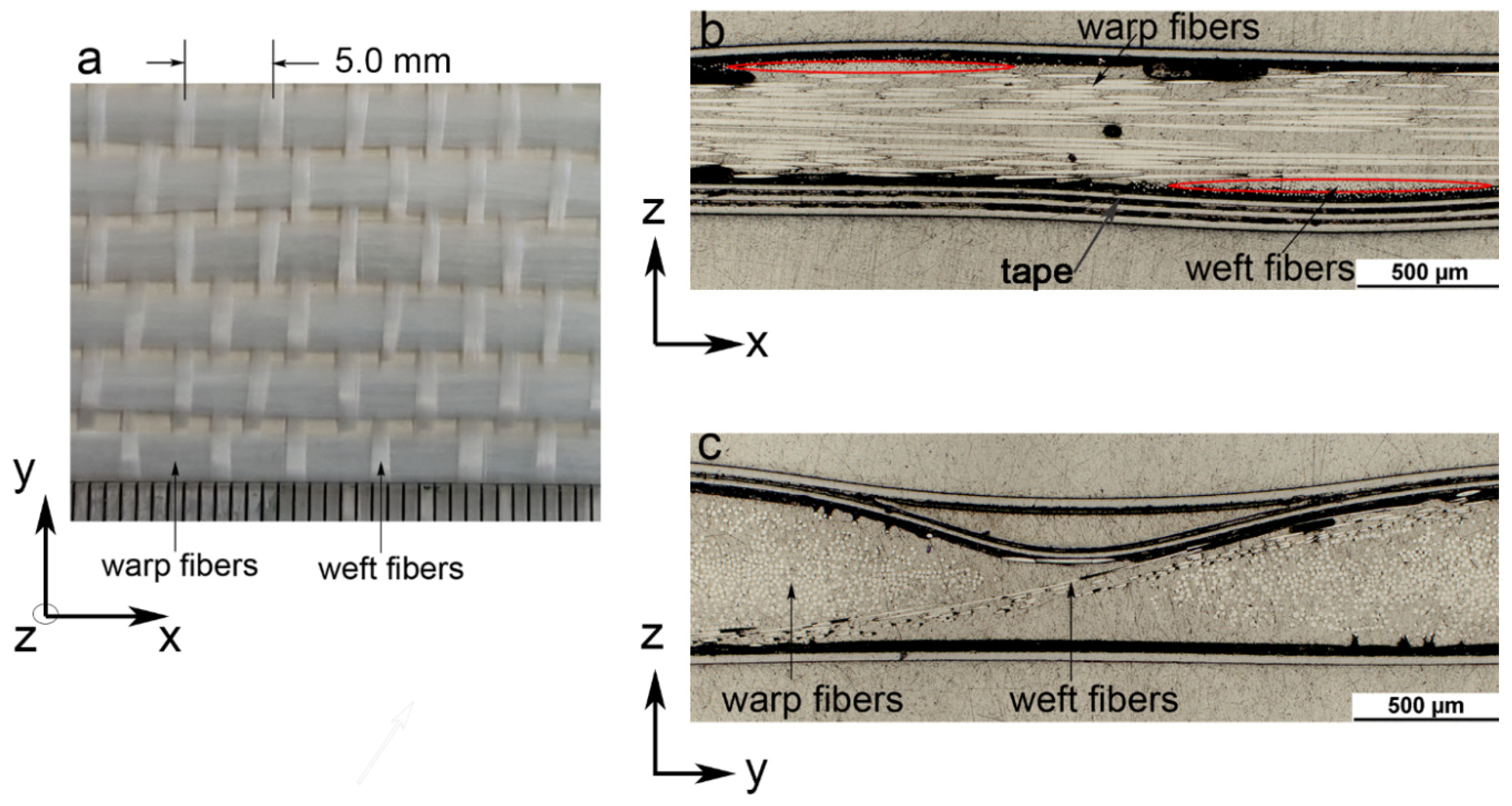



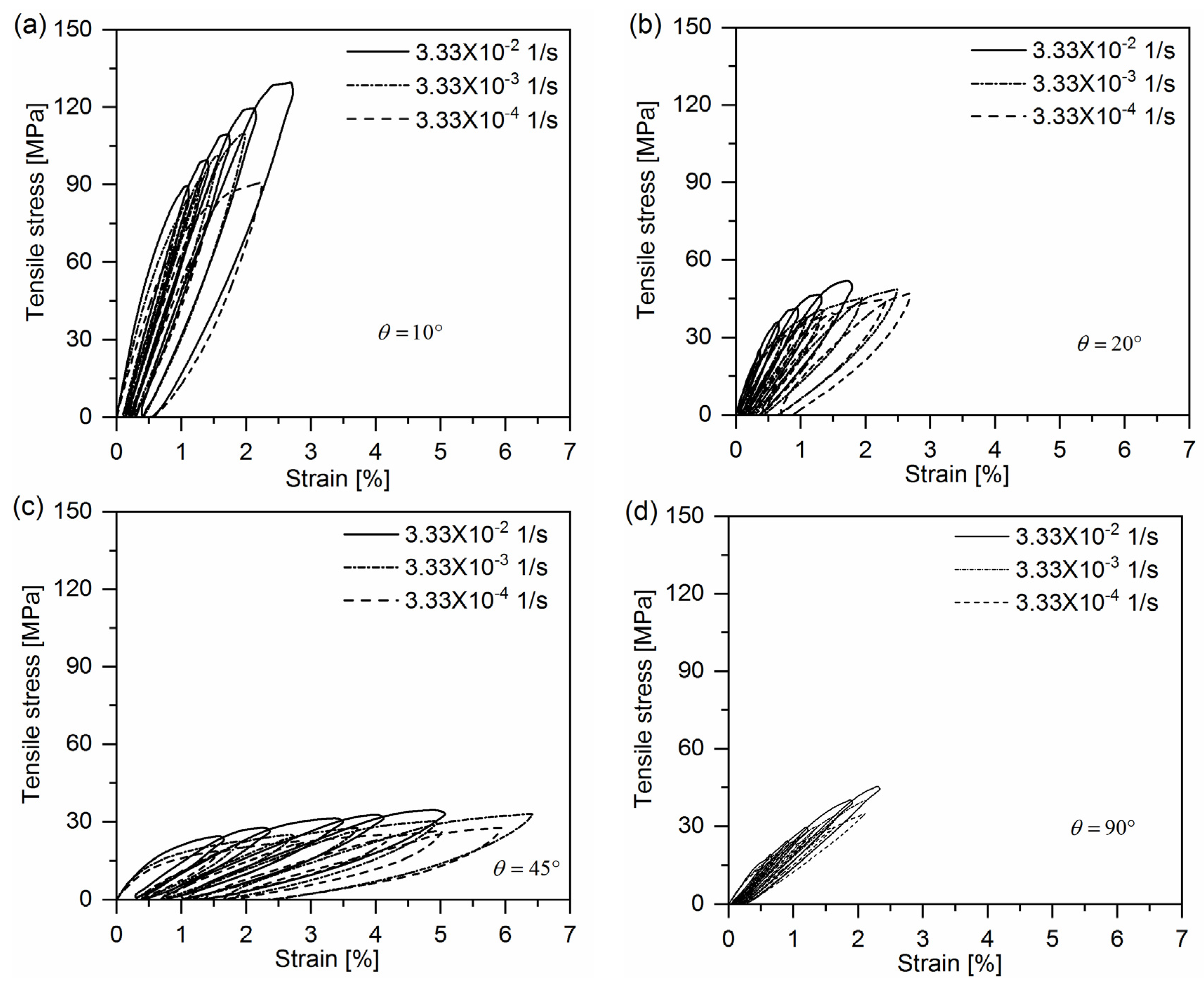
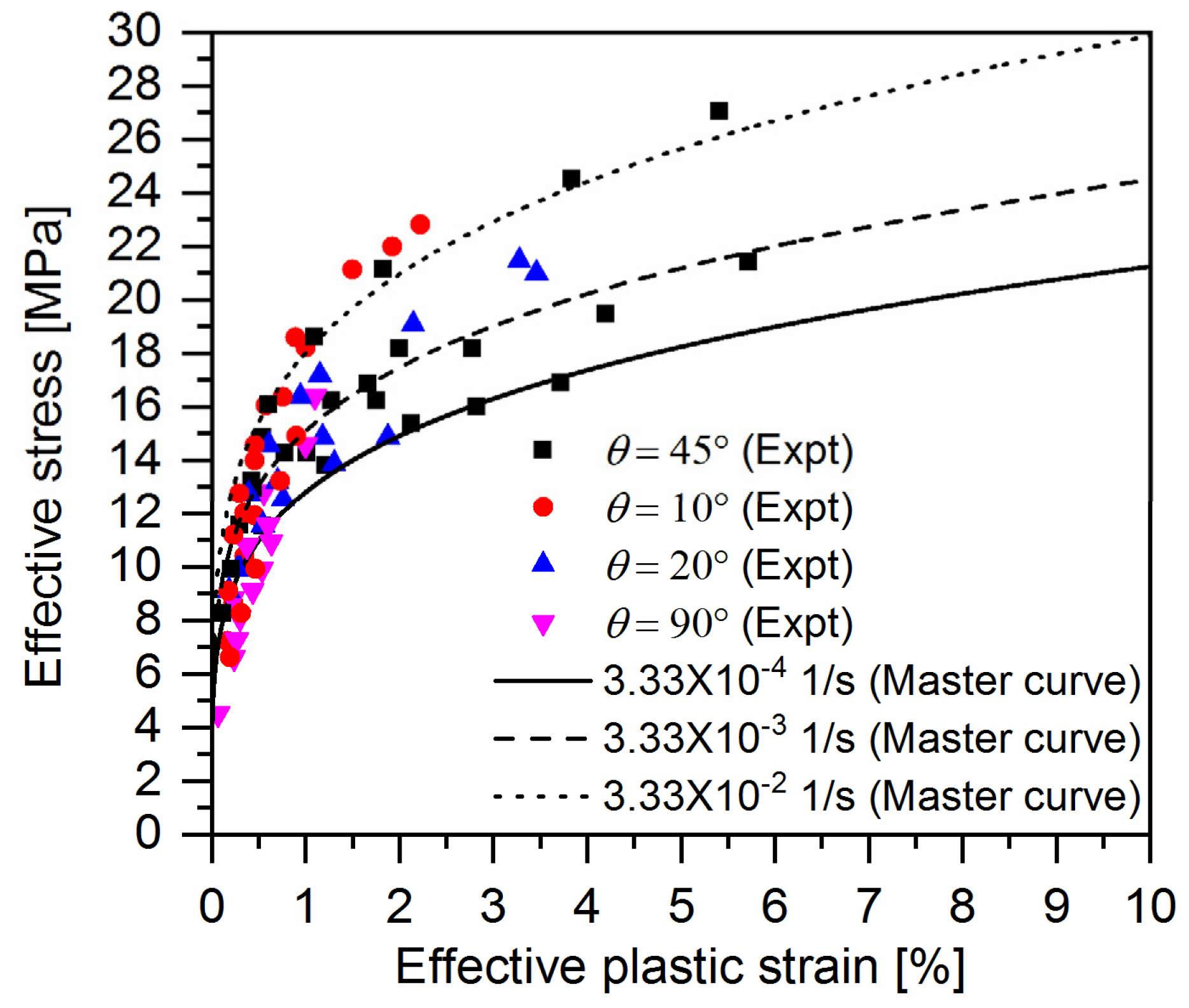
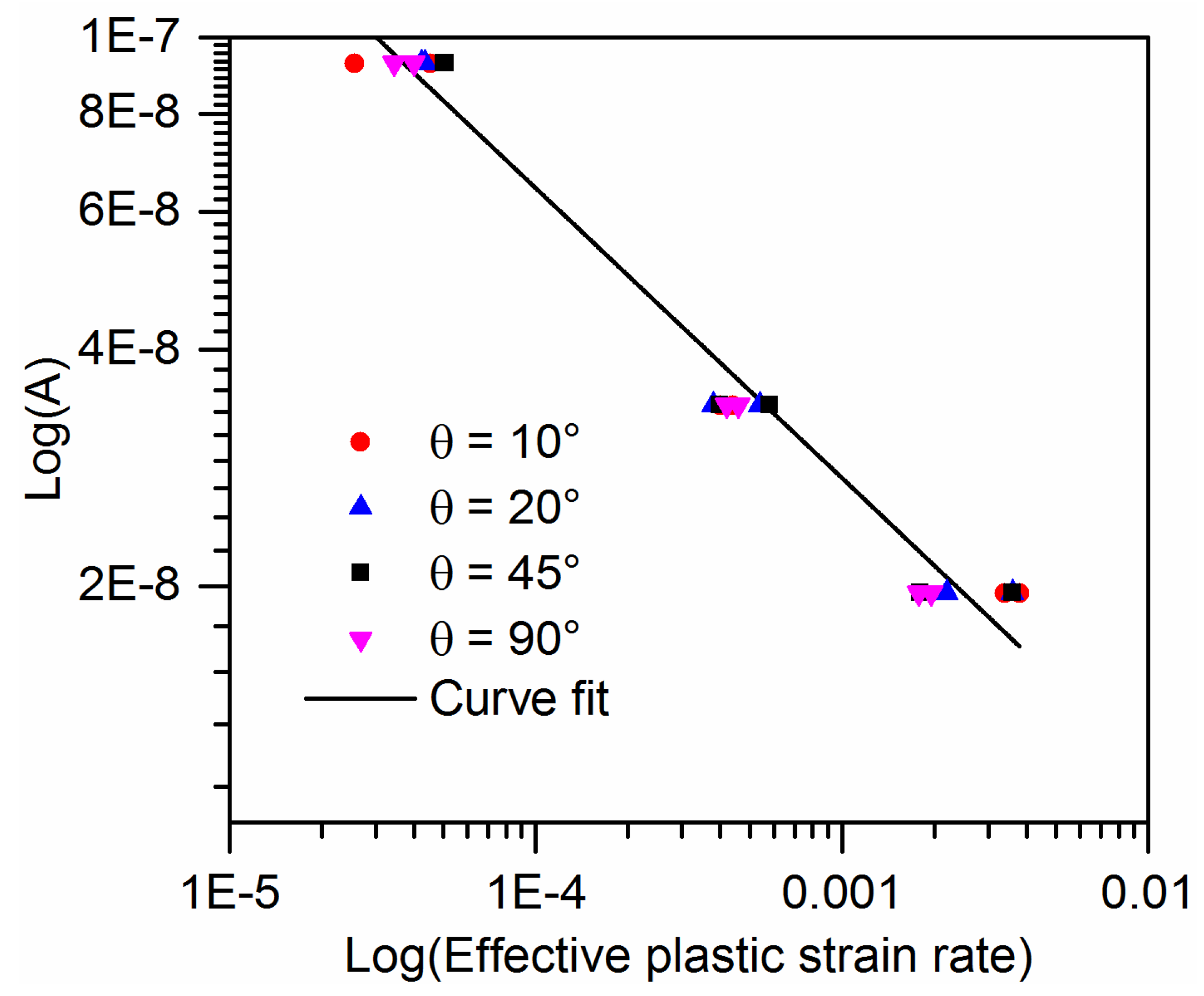

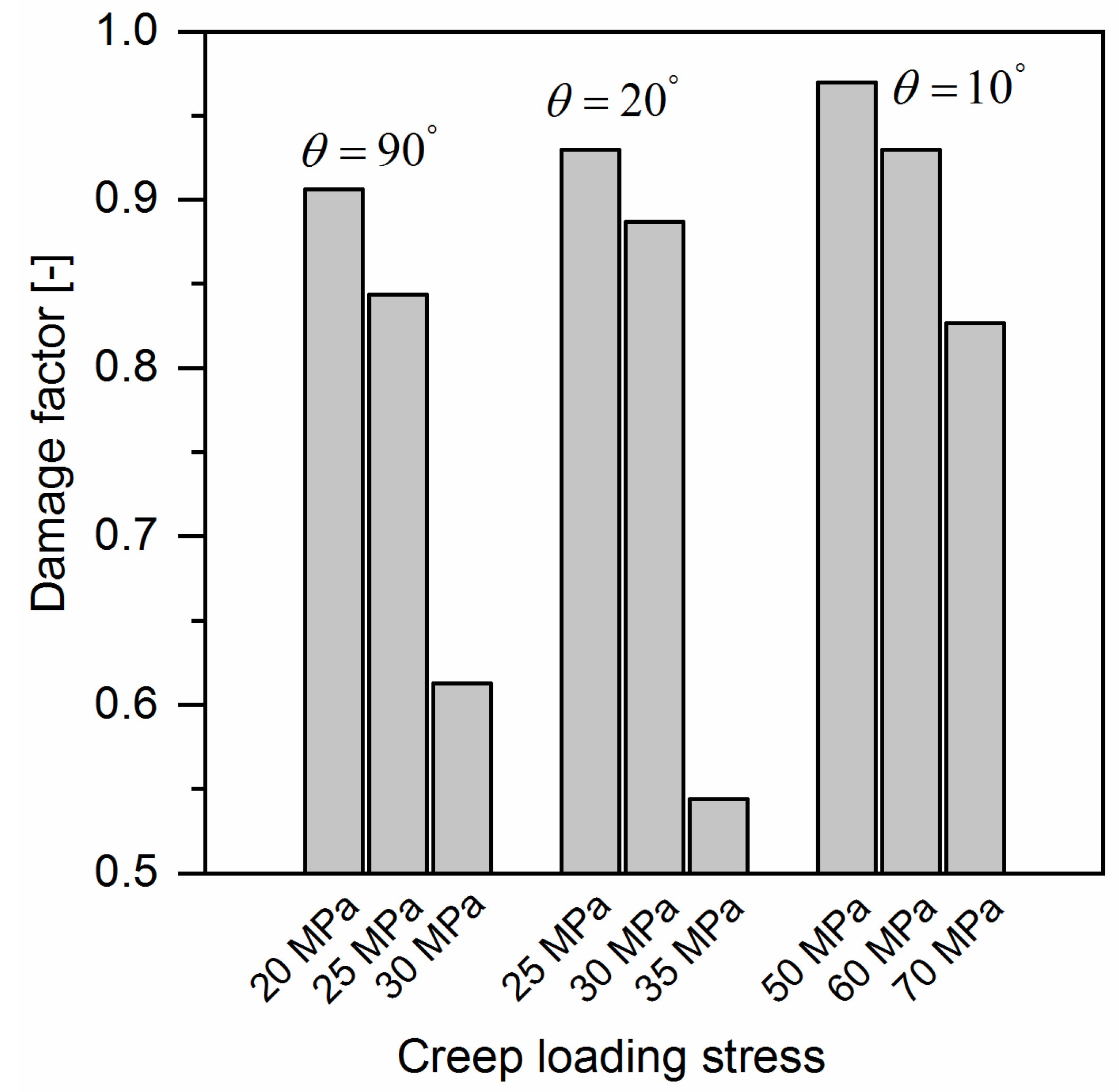
| Off-Axis Sample | Creep Loading Stress (MPa) | Loading Time (h) |
|---|---|---|
| 10° | 20, 25, 30 | 12 |
| 20° | 25, 30, 35 | |
| 90° | 50, 60, 70 |
| Strain Rate (1/s) | Material Constants (Equation (9)) | Plastic Parameters (Equation (10)) | ||
|---|---|---|---|---|
| ((MPa)−n) | ||||
| 3.33 × 10−4 | 0.08 | 0.05 | 9.27 × 10−8 | 4.5 |
| 3.33 × 10−3 | 3.36 × 10−8 | |||
| 3.33 × 10−2 | 1.96 × 10−8 | |||
| −0.36 | |
| −8.7 |
© 2018 by the authors. Licensee MDPI, Basel, Switzerland. This article is an open access article distributed under the terms and conditions of the Creative Commons Attribution (CC BY) license (http://creativecommons.org/licenses/by/4.0/).
Share and Cite
Zhai, Z.; Jiang, B.; Drummer, D. Tensile Creep Behavior of Quasi-Unidirectional E-Glass Fabric Reinforced Polypropylene Composite. Polymers 2018, 10, 661. https://doi.org/10.3390/polym10060661
Zhai Z, Jiang B, Drummer D. Tensile Creep Behavior of Quasi-Unidirectional E-Glass Fabric Reinforced Polypropylene Composite. Polymers. 2018; 10(6):661. https://doi.org/10.3390/polym10060661
Chicago/Turabian StyleZhai, Zhanyu, Bingyan Jiang, and Dietmar Drummer. 2018. "Tensile Creep Behavior of Quasi-Unidirectional E-Glass Fabric Reinforced Polypropylene Composite" Polymers 10, no. 6: 661. https://doi.org/10.3390/polym10060661





